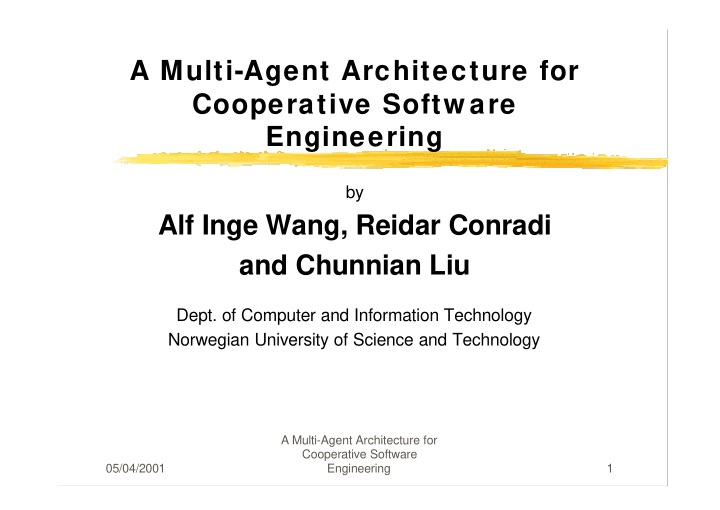



A Multi-Agent Architecture for Cooperative Softw are Engineering by Alf Inge Wang, Reidar Conradi and Chunnian Liu Dept. of Computer and Information Technology Norwegian University of Science and Technology A Multi-Agent Architecture for Cooperative Software 05/04/2001 Engineering 1
Agenda � Background / Motivation � Presentation of a Multi-Agent Architecture � Agents � Workspaces � Agoras � Repositories � An industrial scenario � Application of our Architecture to the Scenario � Conclusion 05/04/2001 2 A Multi-Agent Architecture for Cooperative Software Engineering
Background / Motivation � SPT often focuses on strict organised, pre- planned way of working � Introduce the term CSE � Problem with traditional process architecture: � Too centralised � Too homogenous models � Hard to change tools and models � Need for open-ended spectrum of cooperative process tools 05/04/2001 3 A Multi-Agent Architecture for Cooperative Software Engineering
Multi-Agent Architecture (MAS) � Network of problem solvers � Advantages of MAS are: � Decentralisation � Reuse of previous components � Cooperative work support � Flexibility 05/04/2001 4 A Multi-Agent Architecture for Cooperative Software Engineering
Multi-Agent Architecture for CSE � CAGIS Multi-Agent Architecture: � Agents � System agents � Local agents � Interaction agents � Workspaces � Agoras � Repositories 05/04/2001 5 A Multi-Agent Architecture for Cooperative Software Engineering
Agent � Piece of autonomous software � System agents � Local agents � Interaction agents � Communication agents � Negotiation agents � Coordination agents � Mediation agents 05/04/2001 6 A Multi-Agent Architecture for Cooperative Software Engineering
Workspace (WS) � Human and software agents access shared data and tools � Private and shared workspaces � Shared workspaces used for grouping people 05/04/2001 7 A Multi-Agent Architecture for Cooperative Software Engineering
Agora � Place for software agent interaction � Trading of information and services � Facilities for: � Inter-agent communication � Provide a predefined set of conversation types � Specify a common syntax � Specify a common semantics � Specify pragmatics for agents � Inter-Agent Negotiation 05/04/2001 8 A Multi-Agent Architecture for Cooperative Software Engineering
Repository � Information server � Important types: � Production repository � Experience Base � Software agent services 05/04/2001 9 A Multi-Agent Architecture for Cooperative Software Engineering
Interconnection of components � Agents are created by people � Agents are grouped mainly as people � Interaction between agents is via Agoras � Agents use repositories � Within a group of agents, any process models are allowed 05/04/2001 10 A Multi-Agent Architecture for Cooperative Software Engineering
An industrial scenario � Norwegian Maintenance Development software First line support Development group company Maintenance group � Developing Upd/Rel Plan group products for MS NT and various UNIX platforms Delivery Production & testing Delivery/shipment group Production/QA group 05/04/2001 11 A Multi-Agent Architecture for Cooperative Software Engineering
Multi-Agent Architecture for Cooperative Softw are Engineering Customer reports Defect priority First-line support Maintenance planning Agora 1 register estimate classification allocate forwarding Resources Agora 2 Change Market/Technology EB order requirements Work Update/Release Development order planning coding correction module test update per quarter merging release per year 05/04/2001 12 A Multi-Agent Architecture for Cooperative Software Engineering
Conclusion � Advantages: � Flexible and dynamic support � Secretaries � System adopts to changes � Selection of process models � Disadvantages: � Hard to get overview � Termination of process, dead-locks 05/04/2001 13 A Multi-Agent Architecture for Cooperative Software Engineering
Recommend
More recommend